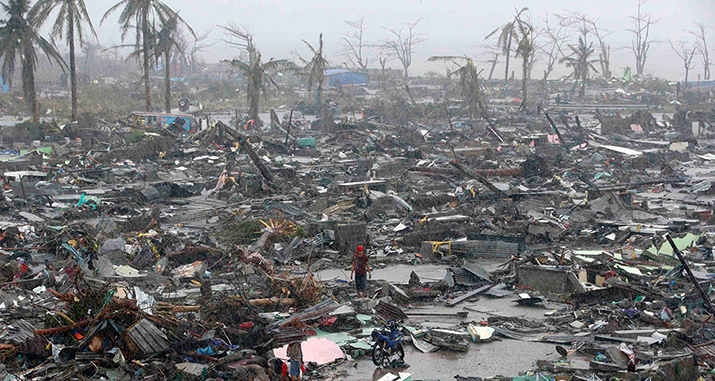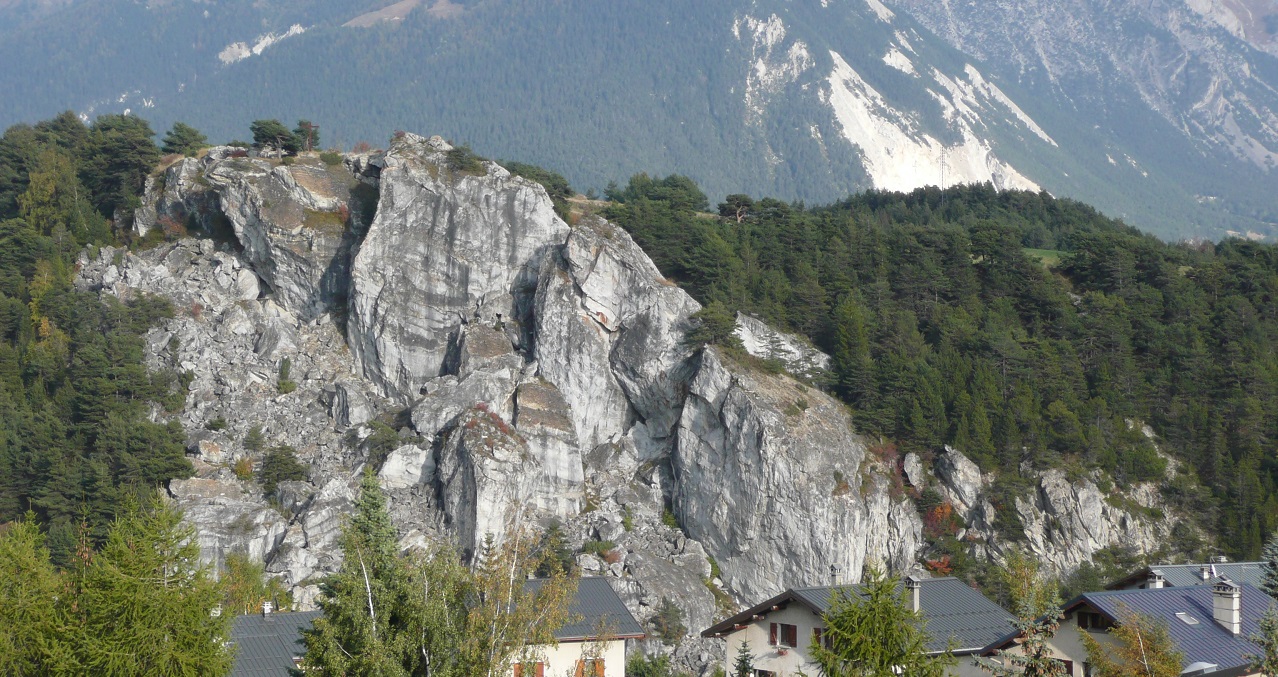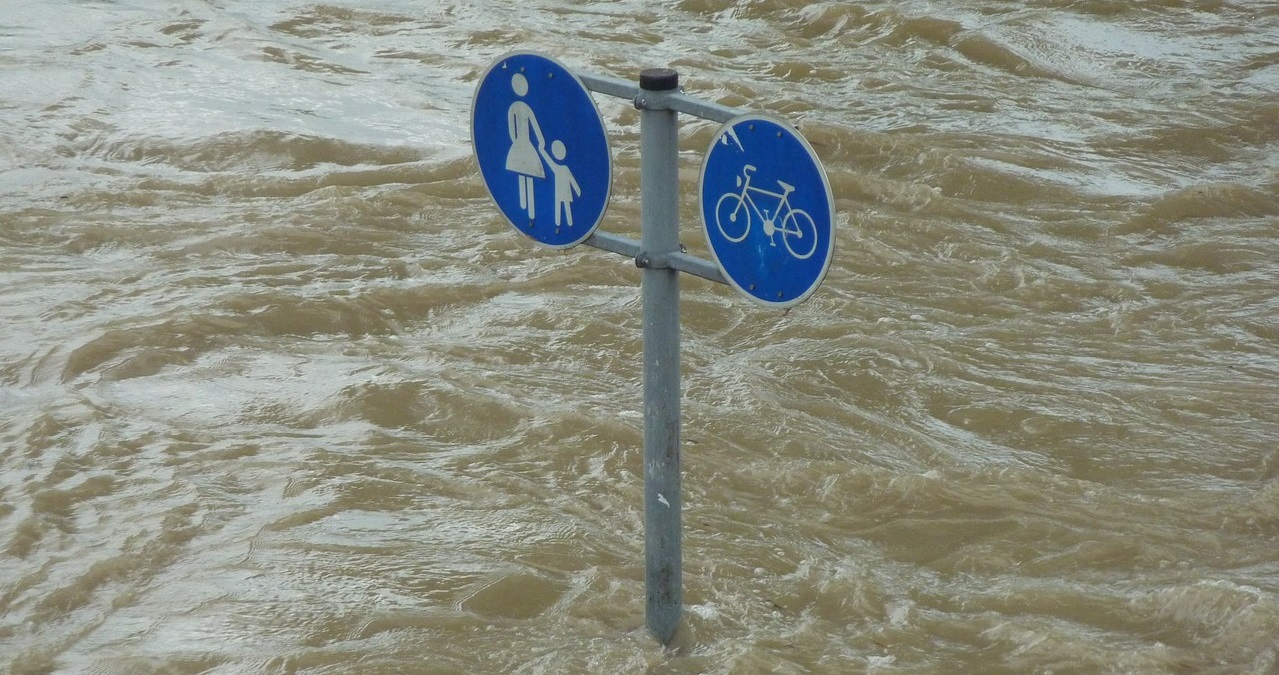Impacts of wind power generation. What is the balance sheet in 2020? What is the outlook?
PDF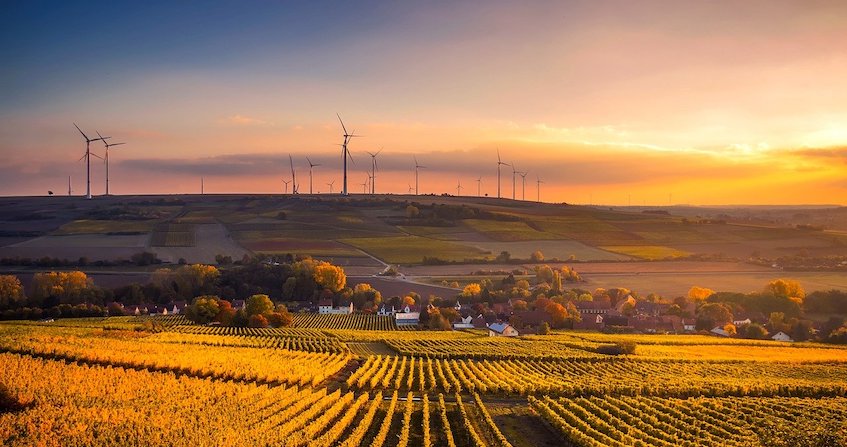
As part of the electricity mix in many countries, wind electrical power is generated by thousands of wind farms spread over the continents and more recently offshore. The expansion of wind farms is being debated and the installation of wind turbines with increasingly large dimensions and power (multi-MW wind turbines) is being criticized, particularly in Europe. In this context, what are the impacts of onshore wind farms on the environment and society as well as on the public electricity network? What is the value of democratic debate and a consensual approach to avoid, reduce and compensate for residual impacts? Moreover, wind-generated electricity is a source of value creation. To reinforce this and mitigate the impacts, an alternative proposal is supported: to favour the development of onshore wind farms which would be of a more compact critical size, grouping together less ostentatious wind turbines. This would alleviate the pressure of wind power installations on the areas. This proposal is associated with the development of offshore wind energy, which has a very high potential off the coasts of all oceans. Thus, the wind energy sector (onshore and offshore) should make a very low-carbon and significant contribution to the global electricity mix in 2050.
The production of wind electricity is ensured by the operation of wind turbines of imposing dimensions and nominal power (multi-MW), which have been continuously increasing over the last decades. These industrial wind farms [1] (see From wind power to electricity production) are the source of impacts on the environment and the population, and are also a source of value creation for the community.
1. Impacts of wind power production facilities

1.1. Analysis and assessment of impacts [3] from onshore wind power plants [4]
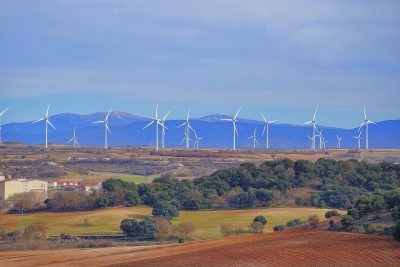
Furthermore, the perception of wind energy in a particular country, the acceptance by the national community or by the local residents differs depending on whether one looks at it from a national or local level or from the vicinity of the wind turbines [6].
Wind farms, which are considered to be of general interest and are intended for industrial electricity generation, give rise to impacts, some of which are felt by local residents to generate conflicts of use. They are summarised below:
- Impacts on landscapes: modification of the “historical” perspective of the territory, visual impacts on environmental heritage, emblematic sites and monuments,
- Impacts on land use, land occupation, housing, commercial or industrial zones, tourist activities if any,
- Impacts on the site’s hydrology and water flow due to land clearing and clearing operations, access roads, tracks or tarmac roads within the wind farm, external works, gravity foundations,
- Impacts on flora,
- Impacts on fauna: insects, animals living above or below ground, breeding and migratory birds, chiropterans, amphibians, etc.
- Impacts on noise emissions: absolute noise level, daytime versus nighttime emergent noise level,
- Impacts on the transmission of radio waves, on radar echoes due to the rotation of the large blades,
- Impacts on the sunshine and lighting of the surrounding land according to the azimuth of the sun: alternation of normal sunshine and shadow according to the rotation of the blades,
- Impacts on the structure of the public electricity distribution or transport network,
- Impacts on the use of sand, raw materials, rare earths and the recycling of these materials and components at the end of the works’ life.
1.2. Industrial risks
Over the entire life cycle of wind power plants, several industrial risks are identified:
- During site development: the risks are typical of large-scale infrastructure and civil engineering works,
- For the transport of large equipments and components by sea or land: these risks are known and controlled by the exceptional transport companies,
- During construction, for the installation in situ of large and heavy components, some of which are placed at great heights, at the top of the mast: the risks are specific to the imposing dimensions of wind turbines (multi-MW machines). They are associated with the use of non-standard lifting equipment by highly specialized teams,
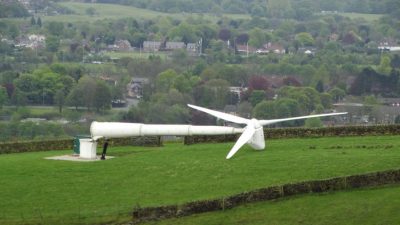
- In the operational phase, i.e. over a period of about 20 years, the risks mainly fall into five categories:
– Risks of intervention and handling at height,
– Risks of intervention on complex electromechanical machines and electrical equipments,
– Risks related to lightning, which can create a weak point on a blade or even cause it to break up suddenly,
– Risks of failure of the mast or rotating components of the wind generator: risk of the wind generator falling to the ground during a “cyclonic” wind event or component fatigue, risk of detachment of a blade or part of the blade [7] leading to a dynamic imbalance which could cause the wind turbine to fall. It should be noted that the choice of wind turbines is specified according to the wind field [8]
– The characteristics, design and strength of the machines must meet the wind speeds and gusts mentioned in the wind resource study,
– The risks of overheating or electrical ignition in the nacelle or mast that could fuel a fire.
Furthermore, when the siting study is well done, the wind turbines are installed in such a way that the risks of the whole machine falling to the ground or of all or part of a blade flying off avoid residential areas, commercial areas, road or rail traffic [9].
Experience from thousands of wind farms in operation around the world shows that wind turbines falling to the ground and the detachment of a blade or part of a blade are exceptional events [10].
Thanks to the experience gained by manufacturers and industry professionals, risk studies and regulatory approvals granted to operators, it appears that wind power generation in OECD countries, and particularly in the EU, has a very low severity rate and is now considered as a very safe technology of electricity generation when accidents – which are infrequent – are analysed over the entire life cycle of the structures and equipments installed.
1.3. Avoid, reduce and compensate impacts. The “ERC” sequence
Capturing wind energy is a question of surface area and the development of wind power plants mobilises or rather neutralises territories. In most countries where this renewable energy is developed, there is a democratic debate around this industrial activity.
The consultation and democratic debate allow the search for and validation of acceptable technical-economic and environmental solutions which aim to improve the balance between the advantages and disadvantages [11] of the project with the objective of preserving the well understood interests of the parties involved.
To this end, the ERC sequence [12]: “Avoid, Reduce, Compensate” for residual impacts provides a framework for dialogue and consultation.
For example, the options available to the project owner to avoid and reduce impacts are:
- The choice of a neighbouring site, other locations for the wind turbines,
- The reduction of the global size of the wind farm (number of wind turbines, unit power),
- The characteristics of the wind turbines: dimensions (rotor diameter, mast height), unit power, aerodynamic regulation (blade profile, power regulation, etc.).
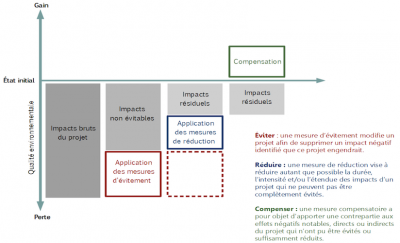
- Examples of financial compensation: purchase or lease of land from owners, land use fee (in some countries or states), tax or fee collected by the locality or community of communes, compensation paid to local residents (compensation for damage to views and/or noise), compensation paid to farmers, compensation paid to associations (bird protection), subsidy for the development of local tourism, subsidy for the renovation of historical monuments, etc.
- Examples of non-material compensation: creation of permanent jobs (operation and maintenance of the production facility), on-the-job training, apprenticeships for young people, provision of labour to support a tourist activity, production of a documentary film to promote the local authority, etc.
1.4. Positive impacts. Wind power generation as a source of value creation
The development of wind farms and the generation of wind electricity are, in the vast majority of sites around the world, a source of positive impacts and value creation for the developer and the community. Very generally, the advantages outweigh the disadvantages. The creation of value can be analysed from various angles, including:
1.4.1. Value creation for the power system and the environment
Every wind turbine in operation converts the available wind energy near the earth’s surface, which is renewable, carbon-free energy, into a quantity of electricity of between 1,700 and 2,200 MWh [13] per installed MW per year, depending on the land site and operating conditions.
The average discounted production cost of electricity (LCOE [14]) from wind power is competitive, ranging from 70 to 80 €/MWh [15 ] in France.
Moreover, this “green” energy is very low carbon [16]. It thus contributes to avoided carbon emissions in most of the electricity mixes of countries that generally have a higher average “carbon” signature due to the operation of fossil fuel power plants.
1.4.2. Value creation for the country
The development of wind farms is accompanied by complex upstream studies and engineering, the execution of infrastructure and civil engineering works (foundations) with high added value [17], in addition to the supply and transport of the wind turbines.
The specific development cost [18] of an onshore wind farm is currently between 1,400 and 1,700 €/MW, of which 1,000 to 1,200 €/MW is for the wind turbine alone (mast, nacelle, rotor, blades).
1.4.3. Value creation for local communities
The operation and maintenance of a wind farm involves the intervention of highly qualified human resources to carry out diversified operations in order to implement imposing machines. These machines embody a complex technology. These operation and maintenance operations are carried out by an experienced multidisciplinary team that works on the site on a daily basis. They result in the creation of permanent jobs [19] in the municipality or the community of municipalities. They represent, on average, the equivalent of 2 to 3 highly qualified full-time jobs that cannot be relocated for every 20 MW of wind power installed on land.
1.4.4. Financial spin-offs: taxes and royalties paid to the State, local authorities and local residents
Wind power plants now have a significant critical size: a few MW to several tens of MW per site for onshore wind farms, several hundred MW for offshore wind farms. They generate a significant industrial activity over the long term, a significant and sustainable turnover and generate significant added value.
This business model, which is now well known and mastered in the countries, gives rise to the payment of various taxes and royalties which depend on the tax legislation and customs in the country in question.
The following is a non-exhaustive list of taxes and other contributions:
- For the benefit of the State: VAT, turnover tax, income tax, national fee or contribution for the public energy service, for the development of the electricity network, etc.
- For the benefit of local authorities: business tax [20] or equivalent, fees for the operation of electrical installations, fees for occupying the public domain, rental of municipal land, etc.
- For the benefit of local residents or landowners: this mainly concerns the sale or rental [21] of private land.
2. Balance sheet and outlook for wind power generation
2.1. What is the situation in 2020?
With the benefit of solid experience consolidated over four decades, wind power generation today appears to be one of the most credible sources of renewable energy to participate in the construction of an efficient, safe and increasingly low-carbon electricity mix on all continents.
However, for a part of the community, for some hostile minorities, the results are mixed, even negative.
What are the arguments of this part of the population that does not see the deployment of wind farms (onshore and/or offshore) as a success, but rather as a relative failure [22] ?
2.1.1. A relative, sometimes limited support of the population to the development of wind projects
In spite of the democratic debate and the consultation process which prevail in democracies, the opponents’ arguments are based on:
- A concentration of wind turbines considered as “aggressive” in regions with high wind energy potential,
- The increasingly imposing dimensions of wind turbines. They are visible from far away; they impose a visual impact on the residents and also on the population of the surrounding communities; they modify and disrupt the landscape, they are likely to devaluate the historical sites as well as the built property, notably the value of the houses,
- Limited involvement of local stakeholders in the financing, development and operation of wind power plants that have an industrial vocation. This type of installation is the responsibility of legal, financial and technical structures that are most often dependent on large electricity companies or industrial groups [23].
2.1.2. The promoters of the wind energy sector have bet on the increase in the power of wind turbines and the critical size of wind farms
The rapid development of wind power plants over the period 1980 – 2020 shows a continuous evolution towards more and more impressive turbines and groupings of wind turbines within wind farms that are increasingly imposing in their dimensions and power. By proposing this evolution, the professionals and actors of the sector have demonstrated that the production of wind electricity is efficient, competitive, reliable and safe. The public authorities have also adhered to this “promise”.
In most OECD countries, in particular in the EU and in France, political decision-makers have developed a legislative and/or regulatory framework that is favourable to this development, one of the objectives of which is to avoid the sprawl of wind farms that could be dispersed over the territories [24].
2.1.3. Another way: smaller onshore wind farms?
Today, it makes sense to consider the design of smaller, less powerful onshore wind power plants [25], spread out over the territory, with a limited number of smaller wind turbines. This would be another way of conceiving land use planning with perhaps more wind farms in the country, but less imposing and considered less aggressive by local populations.
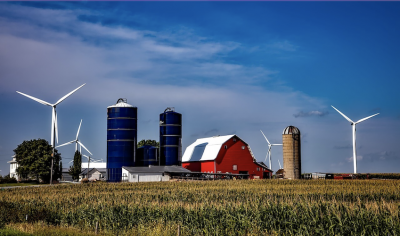
On the other hand, this other conception of wind power generation would have the merit of making production facilities on land more acceptable for the environment, for local communities and their inhabitants, thus reconciling the constraints of an industrial production of decarbonised renewable electricity and the will of local populations to preserve their living environment.
2.1.4. The integration of wind energy on the public electricity network and the sizing of electrical infrastructures
Wind power production is variable and random. The amplitude of the production variations and the uncertainty of the production depend on the wind regime [26].
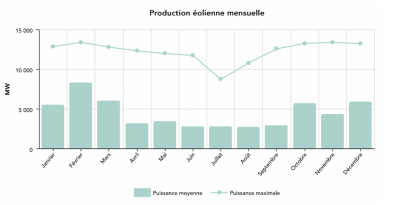
As wind generation plays an increasingly significant role in the electricity mix of many countries, transient phenomena can occur on the electricity transmission network (HV/VHV) that can degrade the voltage and frequency plan. To compensate for these phenomena, the grid operator must call on sufficient reserve capacity to ensure grid stability and meet user demand, in accordance with the specifications in force in the country.
The balance of the electricity system will be maintained if wind power plants are combined with means of adjusting electricity supply and demand: portfolio of consumers with interruptible electricity supply contracts, energy storage devices (STEP: energy transfer stations and hydraulic pumping stations, large-capacity accumulators, hydrogen storage, etc.), “dispatchable” power plants [27].
In addition, the connection of new production sources such as wind farms to the public electricity network requires the resizing of certain transmission and sometimes distribution network facilities to eliminate possible congestion points.
2.2. Putting wind power generation into perspective
2.2.1. Wind energy: a key component of the future electricity mix
Electricity is the energy vector that the community must prioritize in order to move towards an efficient, low-carbon international energy model and move towards carbon neutrality by 2050.
Onshore wind energy, combined with considerable offshore development programs on several continents, is a “key” component of the energy landscape that will play an increasingly significant role in the electricity mix of the future.
In addition to the natural resource that is very well distributed over the different regions of the world, wind power generation benefits from technological progress, which gives it a competitive advantage. It is therefore in a position to occupy an increasingly significant place alongside other renewable energies (biomass, for which the transport of the resource to production plants remains subject to complex and costly logistics, hydroelectricity for which exploitable sites are becoming increasingly rare in OECD countries, and of course photovoltaic and concentrated solar power).

2.2.2. Wind power generation in Europe: a success factor for carbon neutrality in 2050
The European Commission has been supporting the wind energy sector since its industrial take-off in the early 1980s, on the basis of an ambitious R&D programme combined with voluntary incentives.
Observing the technological progress made by the sector, the EU has frequently raised the long-term objectives set for wind power generationand its place in the electricity mix of the European “copper” plate.
Aware of the debate on onshore wind power and of a relative saturation phenomenon perceived by the populations in some high density countries which are today marked by the installation of numerous wind turbines, Europe intends to increase the contribution of wind power in the electricity mix by relying on two success factors:
- The generalization of “repowering” operations [28] to optimize the yield of sites dedicated to wind power generation by replacing wind turbines when they reach the end of their life time,
- The dynamics of large offshore wind power plants, taking into account the considerable offshore wind resource around the EU countries and also the very positive and encouraging performances obtained by the first industrial-scale offshore wind farms (installed capacity: several tens and then hundreds of MW), whose feedback from countries such as the United Kingdom [29], Germany, Denmark, Belgium, the Netherlands, etc. now covers about ten years. Thus, the EU strategy is to increase the installed offshore wind power capacity from 12 GW (excluding the UK) in 2020 to 60 GW in 2030 and sets a target of 300 GW for 2050.
2.2.3. Onshore and offshore wind power: a significant contribution to the global electricity mix in 2050
Although the objective of carbon neutrality by 2050 has not yet been adopted by all developed countries, the main emitters of GHG emissions, renewable energies – all of which are complementary – will play an essential role in the electricity mix of the future. Among these, onshore wind energy will be supplemented, almost to the extent of 50%, by offshore wind energy [30] which will progressively reach most of the seas and oceans, at various distances from the coast.
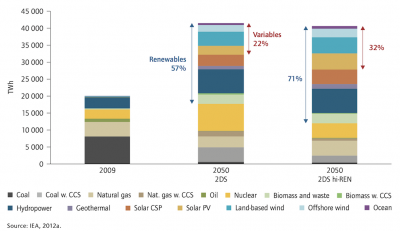
2.2.4. An even greater exploitable wind power potential
More recent prospective studies (2019) assume a greater exploitable wind potential on land and even more offshore. They give renewable energies a possible contribution of up to 86% of the electricity mix in 2050, with a share for onshore and offshore wind power that would approach 20,000 TWh produced (6,044 GW installed).
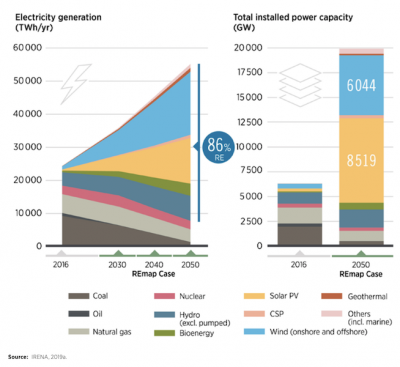
2.2.5. Wind electricity generation: an opportunity for the post-international health crisis
The development of wind power generation is likely to contribute to economic recovery and mitigate the impacts of the COVID pandemic. The wind energy sector (onshore and offshore) has technical and economic characteristics and competitive advantages that are favourable for countries and populations around the world:
- Firstly, the aim is to massively produce clean energy which will replace carbon-emitting fossil fuels in the coming decades and thus contribute to the construction of a sustainable future,
- Secondly, the professionals in the wind energy sector and especially the results of the operation of wind power plants on land and offshore demonstrate that wind power generation is efficient, competitive, reliable and safe. Backed by flexible production capacities and storage devices, wind-generated electricity will be better integrated into public electricity networks and consequently, it will be better valued. In this perspective, it will contribute to technological progress and to the improvement of the economic and environmental living conditions of populations,
- Finally, the massive development of wind power generation, especially offshore, will lead to the realization of productive investments of the first rank on the international scene and the renewal of essential infrastructures. The construction and operation of wind farms will lead to the creation and location of tens of thousands of permanent jobs [31], most of them highly qualified, spread over many countries.
3. Take-home messages
- The generation of electricity by wind turbines with increasingly large dimensions and characteristics (multi-MW turbines) grouped together in industrial wind farms (critical size: several tens of MW on land, several hundred MW offshore) connected to the public electricity grid (medium or high voltage) is the industrial process that optimises the conversion of wind energy into an efficient and renewable energy vector today. In 2019, wind power generation (onshore and offshore) accounted for 1,597 TWh, or 5.9% of global electricity demand.
- However, the development of large wind farms is accompanied by impacts on the environment (landscapes, wildlife, hydrology, neutralization of the land concerned, etc.), on local residents (shadow cast by the rotation of the blades, noise level), on human activities (radar echo, hertzian transmission), on the local economy (depreciation of land and built-up areas in the vicinity and in the surrounding area) and on the electricity system (balance of the grid). These impacts are highlighted by a minority of influential opponents.
- By respecting the legislative context in force in the country, the regulations, standards and provisions of democratic debate (impact study, public inquiry, consultation with elected officials, local residents and associations) the development of wind farms can be agreed on a positive approach: assess and reduce the impacts, compensate for residual impacts.
- The development of offshore wind power since the beginning of the 2000s could encourage countries to limit the progression of onshore wind power installations and thus reduce the pressure of these installations on the environment and society. One option, probably more consensual, would be to give up, especially in areas with high population density, the increasingly excessive characteristics of wind turbines and wind farms that group them. More reasonable wind turbines (recommended nominal power: from 2.5 to 3.5 MW) and less extensive wind farms (cap : more or less 20 MW) could be more appropriate in the general interest.
- There is no doubt that wind power generation is a key component for achieving a low-carbon electricity mix in the future and also a success factor for the energy transition. In the scenarios envisaged for 2050, the contribution of wind energy is essential; based on an annual production of wind electricity of the order of 6,000 to 8,000 TWh (divided between onshore and offshore wind), it should exceed that of hydroelectricity and provide more than a quarter of global electricity generation in 2050.
Notes and references
Cover image. Large onshore wind farm in Germany. Example of industrial wind turbines inserted into the landscape [Source: Pixabay, copyright free]
[1] BESLIN, G., 2021, Du gisement éolien à la production d’électricité par les aérogénérateurs industriels, Encyclopédie de l’Environnement, www. encyclopedie-environnement.org
[2] ADEME, Guide de l’étude d’impact sur l’environnement des parcs éoliens, Actualisation 2010, Ministère de l’Écologie, de l’Énergie, du Développement Durable et de la Mer, www.developpement-durable.gouv.fr
[3] BAFOIL, F., 2016, Wind energy in Europe – Conflicts, democracy, social acceptability, Presses de Sciences Po
[4] We will limit ourselves here to presenting a generic approach for onshore wind farms. Studies on offshore wind power plants are more specific and complex in relation to the location of offshore production facilities. Offshore wind energy is usually classified as marine renewable energy.
Book: Direction générale de l’Energie et du Climat, Guide d’évaluation des impacts sur l’environnement des parcs éoliens en mer, Edition 2017, Ministry of the Environment, Energy and the Sea, www.developpement-durable.gouv.fr
[5] RAPIN, M. and NOËL, J.M., February 2019, Du petit éolien à l’éolien offshore – 3ème édition, DUNOD
[6] There is a difference in the way wind power generation is perceived by society at large and by local residents: for the latter, there may be a high degree of acceptability in view of the local spin-offs, or conversely, an attitude of rejection inspired by the idea of moving the wind power project away from the impacted residents, in reference to the NIMBY reflex: “not in my back yard”.
[7] In this case, we speak of a wind “missile” whose flight can cover a few hundred metres.
[8] Wind turbines are specified for wind classes: IEC IA/IB, IEC IIA/IIB, IEC IIIA/IIIB, IEC S.
[9] In France, wind turbines are currently installed at a minimum distance of 1 km from residential, commercial and industrial areas and traffic routes.
[10] Asian, S., Ertek, G., Haksoz, C., Pakter, S., & Ulun, S., 2017, Wind turbine accidents: a data mining study, Dr Gürdal Ertek’s Publications.
[11] One could also say: enhancing value creation in the face of residual impacts.
[12] The ERC sequence is supported in France by the public authorities in the framework of a democratic debate that is essential to ensure the harmonious development of the wind energy sector.
Guide THEMA : Commissariat général au développement durable, Ministère de l’environnement, de l’énergie et de l’environnement, la mer, in charge of international climate relations, March 2017, www.developpement-durable.gouv.fr, https://www.ecologie.gouv.fr/sites/default/files/Th%C3%A9ma%20-%20La%20s%C3%A9quence%20%C3%A9viter%20r%C3%A9duire%20et%20compenser.pdf
[13] This is the average annual productivity of onshore wind power installations. This production range (1,700-2,200 MWh per MW of installed capacity per year) covers the majority of recent wind power plants in EU countries. From this, the average annual load factor is deduced, which is therefore between 19.4% and 25.1%. For offshore wind installations, the average annual load factor is higher, between 2,800 and 3,200 h/year, to the benefit of the offshore wind field which is more regular.
[14] LCOE: Levelized Cost Of Energy, i.e. the average production cost discounted over the operating life of the production facility (20 years for the vast majority of sites). This cost takes into account the investment cost (CAPEX), the operating and maintenance expenses (OPEX) and the decommissioning cost, discounted to the discounted turnover over the operating period of the electricity production facility.
[15] Source: https: //energie.eelv.fr/la-transition-energetique/comment/leolien/
[16] This is “grey” energy, as the industrial process of converting the wind resource into electricity is CO2-free. For an onshore wind farm, the grey energy is equivalent to about twelve months of the electricity production facility’s deliverable. The carbon content of the onshore wind kWh is between 20 and 30 grams of CO2/kWh (consensus of studies).
[17] Analysis: Costs and profitability of renewable energies in mainland France Onshore wind, biomass, solar photovoltaic, April 2014, Commission de Régulation de l’Energie, www.cre.fr, https://www.cre.fr/Documents/Publications/Rapports-thematiques/couts-et-rentabilite-des-enr-en-france-metropolitaine/consulter-le-rapport
[18] Specific development cost (CAPEX: Capital Expenditure). After decreasing in the previous decade (2010-2020), it is trending upwards against the backdrop of inflation in raw materials: steel, copper, rare earths, etc. The CAPEX of offshore wind farms is higher (close to €3,000/MW) and depends a lot on the characteristics of the offshore site (wind regime, depth of the sea, nature of the subsoil, distance from the coast, etc.).
[19] Report: Wind Observatory, 2019, France Energie Eolienne,www.fee.asso.frhttps://fee.asso.fr/wp-content/uploads/2019/10/2019-wind-observatory-final.pdf
[20] In France, the business tax was reformed in the 2010s. It was replaced by a contribution on the value added of companies (CVAE). In addition, wind power companies are subject to the lump-sum tax for network companies (IFER).
[21] The rent paid to landowners to install wind turbines is negotiated by mutual agreement. It depends on the customary practice in the country or region and varies from one site to another depending on the characteristics of the wind farm: size of the machines, power, number of wind turbines, nature of the land and its previous use. In France, the rent ranges from one to a few thousand Euro per MW installed and per year.
[22] WALKER,R.P., SWIFT,A., 2015, Wind Energy Essentials. Societal, Economic and Environmental Impacts, Wiley Edition
[23] The investments, which amount to several tens of millions or even hundreds of millions of Euros for the largest wind farms, as well as the rigorous and complex operating procedures, leave little room for the population of the communities concerned, whether they volunteer or not, to participate in the board of directors or management of the local wind power company. These industrial power plants do not offer the associative or cooperative character that existed in the 1980s in the Netherlands, Denmark or Germany for the development of wind farms by associations or groups of “small” owners.
[24] In France, the public authorities have elaborated a wind power master plan which defines wind power development zones (ZDE) favourable for the development of wind farms on land and offshore.
[25] Typically: 20 MW maximum, grouped within a wind farm, that is to say the equivalent of 5 to 6 wind turbines limited to 3.5 MW of nominal power per unit.
[26] It is recalled that the wind is more regular offshore than on land. As a result, offshore wind power production is more stable and its short-term prediction is less uncertain.
[27] Gas-fired power plants (CCG: Natural Gas Combined Cycle) which have a launch ramp of a few minutes to reach their nominal power can play a privileged role in ensuring the balance of the electricity network. They also have a carbon footprint (300 to 400 grams of CO2/kWh) that is acceptable for ensuring power adjustment with a limited inrush time.
The experience gained in several European countries where the proportion of wind power is significant (e.g. Germany, Denmark, the Netherlands) has shown that linking wind power plants to fossil-fired base load or semi-base load power plants (coal, lignite, etc.) is problematic in terms of carbon emissions.
[28] Repowering is the redevelopment of a wind farm when the originally installed wind turbines reach the end of their normal life time (about 20 years). In this way, the old machines are replaced by wind turbines of the best current technology. The latter allow a significant increase in the site’s productivity after redevelopment: from 20 to 40% depending on the site.
[29] The United Kingdom, now outside the EU, has been a pioneer in developing demonstration offshore wind farms since the 2000s, and has developed an offshore industry that is among the most efficient based on feedback. Today, the country has 10 GW of wind turbines installed at sea. Offshore wind power around the UK produced 32 TWh in 2019, almost as much as onshore wind power.
[30] BURTON, T.L., JENKINS, N., BOSSANYI, E., SHARPE, D., GRAHAM, M., May 2021, Wind Energy Handbook -3rd Edition, WILEY
[31] The wind industry has already created tens of thousands of jobs in Europe (Germany, Denmark, Spain, the United Kingdom, etc.) in the United States and more recently in Asia-Pacific (China, India, South Korea). And even in France, where the absence of major industrial players is regrettable, the wind industry provides high value-added work to many qualified subcontractors and specialized design offices, as shown by the “2019 Wind Observatory” published by France Énergie Éolienne (https://fee.asso.fr/wp-content/uploads/2019/10/2019-wind-observatory-final.pdf)
The Encyclopedia of the Environment by the Association des Encyclopédies de l'Environnement et de l'Énergie (www.a3e.fr), contractually linked to the University of Grenoble Alpes and Grenoble INP, and sponsored by the French Academy of Sciences.
To cite this article: BESLIN Guy (December 20, 2021), Impacts of wind power generation. What is the balance sheet in 2020? What is the outlook?, Encyclopedia of the Environment, Accessed July 27, 2024 [online ISSN 2555-0950] url : https://www.encyclopedie-environnement.org/en/air-en/impacts-wind-power-generation-sheet-2020-outlook/.
The articles in the Encyclopedia of the Environment are made available under the terms of the Creative Commons BY-NC-SA license, which authorizes reproduction subject to: citing the source, not making commercial use of them, sharing identical initial conditions, reproducing at each reuse or distribution the mention of this Creative Commons BY-NC-SA license.





